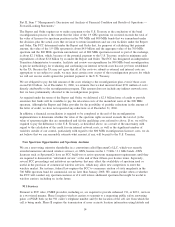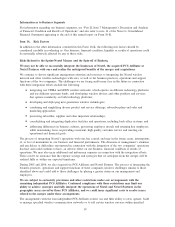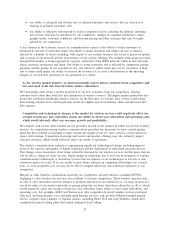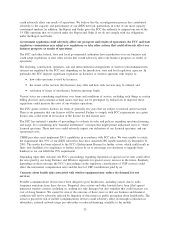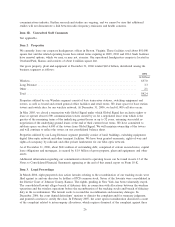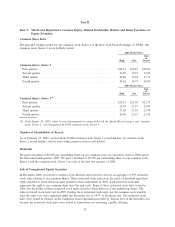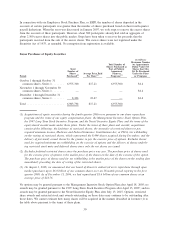Sprint - Nextel 2006 Annual Report Download - page 26
Download and view the complete annual report
Please find page 26 of the 2006 Sprint - Nextel annual report below. You can navigate through the pages in the report by either clicking on the pages listed below, or by using the keyword search tool below to find specific information within the annual report.customer care and billing functions to third parties. We also have entered into an agreement whereby a third
party has leased or operates a significant number of our communications towers, and we sublease space on
these towers. As a result, we must rely on third parties to perform certain of our operations and, in certain
circumstances, interface with our customers. If these third parties are unable to perform to our requirements,
we would have to pursue alternative strategies to provide these services and that could result in delays,
interruptions, additional expenses and loss of customers.
The intellectual property rights utilized by us and our suppliers and service providers may infringe on
intellectual property rights owned by others.
Some of our products and services use intellectual property that we own. We also purchase products from
suppliers, including handset device suppliers, and outsource services to service providers, including billing and
customer care functions, that incorporate or utilize intellectual property. We and some of our suppliers and
service providers have received, and may receive in the future, assertions and claims from third parties that the
products or software utilized by us or our suppliers and service providers infringe on the patents or other
intellectual property rights of these third parties. These claims could require us or an infringing supplier or
service provider to cease certain activities or to cease selling the relevant products and services. Such claims
and assertions also could subject us to costly litigation and significant liabilities for damages or royalty
payments, or require us to cease certain activities or to cease selling certain products and services.
If Motorola is unable or unwilling to provide us with equipment and handsets in support of our iDEN
based services, as well as anticipated handset and infrastructure improvements for those services, our
operations will be adversely affected.
Motorola is our sole source for most of the equipment that supports the iDEN network and for all of the
handsets we offer under the Nextel brand except primarily for BlackBerry devices. Although our handset
supply agreement with Motorola is structured to provide competitively priced handsets, the cost of iDEN
handsets is generally higher than handsets that do not incorporate a similar multi-function capability. This
difference may make it more difficult or costly for us to offer handsets at prices that are attractive to potential
customers. In addition, the higher cost of iDEN handsets requires us to absorb a larger part of the cost of
offering handsets to new and existing customers. These increased costs and handset subsidy expenses may
reduce our growth and profitability. Also, we must rely on Motorola to develop handsets and equipment
capable of supporting the features and services we plan to offer to subscribers of services on our iDEN
network, including a dual-mode handset. A decision by Motorola to discontinue manufacturing, supporting or
enhancing our iDEN-based infrastructure and handsets would have a material adverse effect on us. In addition,
because iDEN technology is not as widely adopted and has fewer subscribers than other wireless technologies
and because we expect that over time more of our customers will utilize service offered on our CDMA
network, it is less likely that manufacturers other than Motorola will be willing to make the significant
financial commitment required to license, develop and manufacture iDEN infrastructure equipment and
handsets. Further, our ability to timely and efficiently implement the spectrum reconfiguration plan in
connection with the FCC’s Report and Order is dependent, in part, on Motorola.
The reconfiguration process contemplated by the FCC’s Report and Order may adversely affect our
business and operations, which could adversely affect our future growth and operating results.
In order to accomplish the reconfiguration of the 800 MHz spectrum band that is contemplated by the Report
and Order, in most cases we will need to cease our use of a portion of the 800 MHz spectrum on our iDEN
network in a particular market before we are able to commence use of replacement 800 MHz spectrum in that
market. To mitigate the temporary loss of the use of this spectrum, in many markets we will need to construct
additional transmitter and receiver sites or acquire additional spectrum in the 800 MHz or 900 MHz bands.
This spectrum may not be available to us on acceptable terms. In markets where we are unable to construct
additional sites or acquire additional spectrum as needed, the decrease in capacity may adversely affect the
performance of our iDEN network, require us to curtail subscriber additions in those markets until the capacity
limitation can be corrected, or a combination of the two. Degradation in network performance in any market
could result in higher subscriber churn in that market, the effect of which could be exacerbated if we are
forced to curtail subscriber additions in that market. A resulting loss of a significant number of subscribers
24


